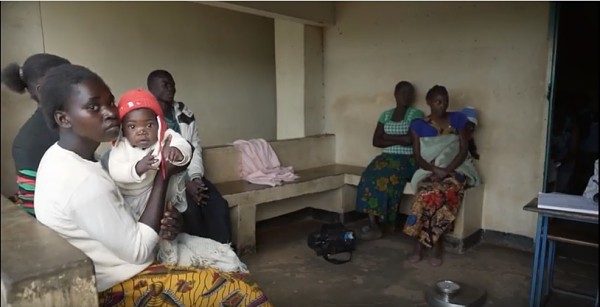Is it time for Finnish celebrities to save black girls of a “developing country”? This is the question that might occur to someone familiar with post-colonial studies observing the newest campaign of the Finnish section of the international aid agency Plan International. The recent advert of the aid agency portrays a black pregnant girl, too young to become a mother, in her maternity clothes. Entitled ”Maternity wear for a 12-year old by Paola Suhonen”, the campaign, didn’t go unnoticed by those using Finnish public transportation, Finnish-language online spaces, or skimming through national newspapers. Advertisement portraying pregnant women is uncommon in Finland, and advertisement showing black women is equally rare. So why then black pregnant girls? The text, “Make sure they are not needed,” which accompanies the picture of the pregnant girl in her new clothes designed and delivered to her by a well-known Finnish fashion designer reveals that Finnish celebrities seem to have turned humanitarian.
Led by two public figures in Finland, the campaign ”Maternity wear for a 12-year old by Paola Suhonen” follows the pattern of celebrity humanitarianism. Yet, in view of the history of Finland, the campaign should also be situated within the nation’s self-understanding as a ‘developed’ and ‘progressive nation’. The ways in which the campaign relies on racialization in order to define a certain unlimited geographic region – ‘a developing country’, needs to be challenged.
Celebrities’ adoption of humanitarianism causes is not a new phenomenon for anthropologists and scholars of international development. Yet, until recently we had not witnessed Finnish celebrities in this particular savior role.
It has been missionaries, development aid workers sponsored by the state and self-proclaimed peacebuilders such as the former president of Finland who have taken on the responsibility as the country’s ambassadors in saving the “distant Other” in faraway places plagued by conflict. Following the opening of the markets, it has only been in the past decades that such global initiatives have found their way to Finland. Notably, Plan International was established in 1937 but it only opened an office in Finland in 1998. Plan’s campaign ”Maternity wear for a 12-year old by Paola Suhonen”, therefore, does not only speak for the global power relations and hierarchies but is says a lot about Finland’s changing self-image as a story of progress: from a poor post- second world nation to a pioneering nation in international development.
For the stars of the global entertainment world, humanitarianism has functioned as a tool to boost their brand.
They all have in common, that they operate in the ‘Aidland’, that is, the part of the world that is defined as in need of humanitarian assistance and where different development aid agencies operate. Anthropologists have critically engaged with several such initiatives including Bob Geldof’s Band Aid in 1984 and other, more recent, initiatives by celebrities of the global entertainment world such as Bono, Angelina Jolie, Leonardo DiCaprio, Madonna and others (Biccum 2016; Kapoor 2012; Nickel & Eickenberry 2008; Yrjölä, 2014).
https://youtu.be/AvcbPvSRZ-I
The short videos are the campaign’s most effective tool for familiarizing the audience with the “distant Other”, and consolidating the donor’s own position as they introduce the “shocking” context of a “developing country” to the Finnish audience. Big numbers make the campaign meaningful, give it justification and legitimacy. One of the short campaign videos entitled “Making of Maternity Wear For a 12-Year-Old” precisely begins with big shocking numbers: ”Every year 7 million children in developing countries become mothers”. Yet, the number – the amount of “child pregnancies” – remains without a context as does the term ”developing countries” where these child pregnancies occur. Sally Merry (2016) has pointed to the downside of explaining such phenomena (violence against women or child pregnancies in this case) with statistical information; it homogenizes and separates problems from larger structural issues. The Plan campaign operates with such homogenizing categories “developing countries” and “child pregnancies.”
After the campaign video has revealed the “shocking amount” of child mothers in “developing countries”, these anonymous seven million child pregnancies are concretized by footage of young black girls carrying their babies in the courtyard of an unnamed place. The video presents the girls as idle and passive. In order to ensure that the reader will not misinterpret what she sees, the video also brings to the viewer’s screen the girls’ teacher who explains what the video tries to visualize: “They [the girls] will be in their village doing nothing and at the end they will be engaged in other activities like prostitution so that they can have money to feed themselves and the kids”. It seems that for the campaign designers the black skin color tells enough about the context. The skin color is meant to indicate to the Finnish audience that it is a question of one of those “developing countries” where girls become pregnant at a too young age. The girls are racialized – their black skin color speaks for their lower social, cultural and economic status. Through the pre-existing knowledge that the audience already possess about “developing countries”, it can easily access the information and make the necessary connections between the space portrayed in the video and the category “developing country”.
“Maternity wear for a 12-year old by Paola Suhonen” relies on a third generalizable category, that of a ”girl”. Feminists have long posed the question of whether all women share enough in order to constitute a universal category ”girls” (or “women” for that matter) (Mohanty 1991; Hooks 2000; Abu-Lughold 2013). Think of an encounter between a white, Finnish 12-year old girl and a billboard portraying the “12-year old black girl in her new maternity clothes” at a bus stop in Helsinki. What kinds of associations does the white girl make when she stares at the objectified black pregnant girl? Her associations would most likely build on the overall politics and demographics prevalent in Finland, in which black people are mostly seen on the pages of aid brochures calling for help for the abstract place called “developing country”. The street picture, mainstream media and politics in Finland are predominantly occupied by white people and portray a high degree of homogeneity. The image of the black pregnant girl provides a sufficient contrast to the rapid progress of Finland from a colonized country to a nation pioneering gender equality – the new gender-neutral school curriculum is a most recent attestation of this. It suggests that children should not be divided according to the categories “girl” and “boy” anymore. The campaign therefore serves to juxtapose the white, Finnish 12-year old girl, an individualized person as the above-mentioned school curriculum advocates, and the black child mother of the billboard who is meant to represent all the seven million pregnant girls of “developing countries”? Projects that aim at saving others can enforce the feeling of one’s superiority (Abu-Lughold 2013). Instead of generating solidarity between the donor and the recipient, such campaigns could easily consolidate feelings of superiority and self-image of one’s own progress seen in relation to the ‘Others’, enforce racist attitudes locally and make the “distant Other” more distant. The challenge is how to create non-hierarchical and emancipatory relationships. And how to give voice to the story’s protagonist instead of silencing her and depriving her of her agency.
The campaign only functions on the abstract level (Kapoor 2012) producing knowledge about developing countries, or ‘Aidland’ (Mosse, 2011). That the distant ‘Other’ is located in Zambia is barely mentioned in the campaign materials. The local complexities and problems plaguing Zambia such as extractive forms of capitalism, mine industry in particular, reminiscent of the colonial period would otherwise overwhelm the campaign planners (Fredriksen 2014). In fact, Zambia is mentioned in the campaign video only when two Finnish celebrities travel there with their crew. It is not Angelina Jolie, a familiar face in images of humanitarian action, but a photographer Meeri Koutaniemi, who made her career by picturing female genital mutilation practices in Kenya to global audiences, who climbs to the SAS plane by holding a café latte. The other celebrity of the campaign is fashion designer Paola Suhonen. The mission of the Nordic artists is to produce knowledge about “developing countries” and “black racialized girls” to the Finnish audience. In order to sell the campaign to broad audiences and attract donors, early motherhood is isolated from other issues and global power relations (Kapoor 2012). The campaign stars’ ability to narrate a story of an abstract “developing country” by using Zambia as the stage of their theater play best visualizes this power relation and speaks for the self-image of the Finnish audience.
Photographing “black pregnant girls” and telling stories about them becomes glorified as a heroic act. It normalizes the position of Finland among the developed and progressive nations.
With an astonishing accuracy, the campaign video follows the pattern of celebrity humanitarianism seen in other contexts. When the white Finnish celebrities step out of the Ethiopia Airlines aircraft in the unidentified “developing country”, they are followed by a group of black men. Soon the scenes on the screen change – clean airport environment and the take away latte are replaced by shantytowns. From behind their sunglasses in the safety of the SUV-car, the two white Finnish women glance outdoors. Upon their arrival in the destination, the Finnish celebrity assumes the role of an expert. From the unnamed location, she explains to the Finnish audience the causal relationship between child marriages and child pregnancies.
As post-colonial scholars frequently remind us, representations of third world women as passive and deprived of their agency have a long history. Nothing would visualize this better than what ensues in the video: while we hear the voice of the Finnish speaker in the background, the camera turns to the black girls. Mute women, standing speechless in the picture and wearing worn out clothes made of colorful fabrics are again represented with their babies as passive – speechless and not moving much – transmitting an image of them waiting for the help of Finnish donors. Indeed, the girls constitute the opposite image of the Finnish photographer who sits her back straight and wears jewelry. The child mothers of “developing countries”, whose stories are being told, become a resource for the two Finnish celebrities (Kapoor 2012; Yúdice 2005). Hence, the campaign follows a market logic – everything becomes sellable, even the big belly of an under aged girl (Biccum 2016).
The “third world” or “developing countries” and former colonies provide career opportunities and resources for specialists of International development (Petreus 1999) and for the colonizer respectively. Just as the careers of development aid workers are connected to their places of origin (Smirli 2008) or their organizations with headquarters in Western capitals, so is the fame of the Finnish celebrities connected to their place of origin – art circles, fashion world and Finland. The child mothers of “developing countries” provide a resource for the celebrities that contributes to their uncritical celebration as part of the Finnish elite society by their constituency (Nickel & Eickenberry 2009). The celebrities take on the role of ambassadors with the mission of reminding the Finnish audience how advanced Finland is and how underdeveloped the “Others” are. This constitutes a form of “proxy humanitarianism”. Proxy humanitarianism involves the principle of deresponsibilization of the constituency, that is, a text message worth of 15 euros to Plan international becomes an act of charity that delegates the humanitarian work to the celebrities – “global [Finnish] super models”. (De Lauri 2016)
The campaign video ends with a short fashion shoot. The potential Finnish donor witnesses how three fashionable white women meet (to borrow their words) the story’s ”main girl”. In contrast to the fashionable Finnish women, “the main girl” is wrapped in a blanket. As in most fashion shoots, the “main girl,” Fridah becomes objectified, instrumentalized for the campaign’s purposes. Fridah poses on the field while the Finnish fashion designer explains the reasons behind her choices of color and style. Instead of local colors, the designer searched for tones in children’s fashion world and chose “Hamptons style” – soft tones such as light blue and creamy colors. Oppositions are at play again – the maritime spirit was chosen as a contrast to the girls’ living conditions, the designer explains. The pictures of mute and passive girls in colorful worn-out clothes change to pictures of kids who play in “Hampton’s style clothing”. The international fashion world brought to an abstract place called “a developing country” by representatives of the Finnish donor audience is portrayed as a talisman that brings happiness and change. The video limits the conditions of possibility to the benevolence of the white Finnish donors. At the same time the local meanings, such as the colorful fabrics and daily joys of the people are not given any value but obliterated. The campaign that is sold to the Finnish audience by statistical numbers, technical knowledge and racialized images, further normalizes the position of the Finns on the side of the saviors.
A shorter version of this essay appeared originally in the Finnish-language AntroBlogi as a part of the online publication’s new ‘Current Affairs’ section.
References:
Abu-Lughold, Lila. 2013. Do Muslim Women need saving? Cambridge, Massachusetts & London, England: Harvard University Press.
Biccum, April R. 2016. What might celebrity humanitarianism have to do with empire?, Third World Quarterly, 37:6, 998-1015,
De Lauri, Antonio (ed.). 2016. The Politics of Humanitarianism: Power, Ideology and Aid. London & New York: I.B.Tauris.
Eikenberry, A.M. & Nickel, P.M. 2009. “A Critique of the Discourse of Marketized Philanthropy.” American Behavioral Scientist 52 (974).
Fredriksen, Tomas. 2014. “Authorizing the “Natives”: Governmentality, Dispossession, and the Contradictions of Rule in Colonial Zambia.” Annals of the Association of American Geographers 104 (6):1273-1290.
Hooks, bell. 2000. Feminism is for everybody: passionate politics. Cambridge: South End Press.
Jamar, Astrid. 2017. “Breakfast in Aidland: Quatidian Relations and Structural Contradictions”. Allegralaboratory.net.
Merry, Sally. 2016. Seduction of Quantificaton: Measuring Human Rights, Gender Violence and Human Trafficking. The University of Chicago Press.
Mohanty. Chandra Tapade. 1991. “Under Western Eyes: Feminist Scholarship and Colonial Discourse”. Feminist Review (30).
Kapoor, Ilan. 2012. Celebrity Humanism: The Ideology of Global Charity. Edited by Nick Vaughan-Williams Jenny Edkins, Interventions. Oxon: Routledge.
Mosse, David. 2011. Adventures in Aidland: The Anthropology of Professionals in International Development. Studies in Public and Applied Anthropology. Berghahn Books.
James, Petras. 1999. “NGOs: In the Service of Imperialism.” Journal of Contemporary Asia 29 (4).
Yrjölä, Riina. 2014. The Global Politics of Celebrity Humanitarianism. Jyväskylä: University of Jyväskylä.
Smirl, Lisa. 2008. “Building the Other, Constructing Ourselves: Spatial Dimensions of International Humanitarian Response.” International Political Sociology 2 (3).
Spivak, Gayatri Chakravorty. 2004. “Righting Wrongs.” The South Atlantic Quarterly 103 (2/3)











That yet unborn child can´t choose the color of the skin, (unlike the parents). You, yet in fertile age being (rather) ebony woman, would you become to those yet unborn chilldren of ours…